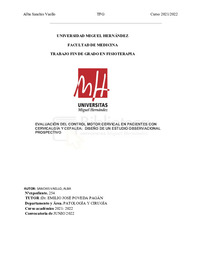Por favor, use este identificador para citar o enlazar este ítem:
https://hdl.handle.net/11000/28182Registro completo de metadatos
| Campo DC | Valor | Lengua/Idioma |
|---|---|---|
| dc.contributor.advisor | Poveda Pagán, Emilio José | - |
| dc.contributor.author | Sanchís Vaello, Alba | - |
| dc.contributor.other | Departamentos de la UMH::Patología y Cirugía | es_ES |
| dc.date.accessioned | 2022-11-02T13:26:50Z | - |
| dc.date.available | 2022-11-02T13:26:50Z | - |
| dc.date.created | 2022-06-20 | - |
| dc.identifier.uri | https://hdl.handle.net/11000/28182 | - |
| dc.description.abstract | Introducción: La prevalencia del dolor cervical en España es elevada, siendo una de las enfermedades crónicas más importantes. Una de las posibles causas originales y/o perpetuadoras pueden ser una mala activación de la musculatura estabilizadora de cuello, mostrando un control motor deficiente. Hipótesis y objetivos: Nuestro objetivo será realizar un estudio observacional prospectivo en mujeres mayores de 30 años con dolor cervical y de cabeza para observar el déficit de activación de los flexores profundos cervicales al realizar test de control motor cervical con el stabilizer. Metodología: Se evaluará el control motor cervical a 195 pacientes seleccionados a partir de un cuestionario de google, mediante el uso del Stabilizer, realizando el “Test de Flexión Craneocervical”. Además, también se utilizarán otras escalas complementarias como es la escala visual analógica para el dolor (EVA), el índice de discapacidad cervical (IDC) y Temporomandibular Pain Disorder Screening Instrument. | es_ES |
| dc.description.abstract | Introduction: The prevalence of neck pain in Spain is high, being one of the most important chronic diseases. One of the possible original and/or perpetuating causes may be poor activation of the stabilizing muscles of the neck, showing poor motor control. Hypothesis and objectives: Our objective will be to carry out a prospective observational study in women over 30 years of age with cervical and headache pain to observe the activation deficit of the deep cervical flexors when performing cervical motor control tests with the Stabilizer. Methodology: Cervical motor control will be evaluated in 23 patients selected from a google questionnaire, through the use of the Stabilizer, performing the "Craniocervical Flexion Test". In addition, other complementary scales will also be used, such as the visual analog scale for pain (VAS), the cervical disability index (IDC) and the Temporomandibular Pain Disorder Screening Instrument. | es_ES |
| dc.format | application/pdf | es_ES |
| dc.format.extent | 28 | es_ES |
| dc.language.iso | spa | es_ES |
| dc.publisher | Universidad Miguel Hernández | es_ES |
| dc.rights | info:eu-repo/semantics/openAccess | es_ES |
| dc.rights | Attribution-NonCommercial-NoDerivatives 4.0 Internacional | * |
| dc.rights.uri | http://creativecommons.org/licenses/by-nc-nd/4.0/ | * |
| dc.subject | Músculos del cuello | es_ES |
| dc.subject | Dolor crónico del cuello | es_ES |
| dc.subject | Columna cervical | es_ES |
| dc.subject | Dolor de cabeza | es_ES |
| dc.subject | Fisioterapia | es_ES |
| dc.subject.other | CDU::6 - Ciencias aplicadas | es_ES |
| dc.title | Evaluación del control motor cervical en pacientes con cervicalgia y cefalea: Diseño de un estudio observacional prospectivo | es_ES |
| dc.type | info:eu-repo/semantics/bachelorThesis | es_ES |

Ver/Abrir:
TFG ALBA SANCHIS VAELLO.pdf
3,42 MB
Adobe PDF
Compartir:
 La licencia se describe como: Atribución-NonComercial-NoDerivada 4.0 Internacional.
La licencia se describe como: Atribución-NonComercial-NoDerivada 4.0 Internacional.
.png)